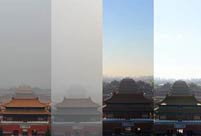"But creativity can't come from nowhere; there are rules for it - preservation, selection and transformation," said Wang.
Following this basic principle, Wang listed up to 40 specific methods for developing cultural products that can be sold. One of these involves what is described as "merging".
This sees a museum object reproduced in combination with other practical implements, such as a spoon or a screwdriver.
Another option is to reproduce a museum object with different materials. The Jade Cabbage - the key highlight of the Palace Museum in Taipei - has been reproduced with materials such as glass, resin and food.
Wang said that one of the top-selling items at Taipei's Palace Museum is a pair of women's tights that combines the lotus pattern from the Ru-kiln porcelain of the Northern Song Dynasty (960-1127) and the blue tone from the Longquan-kiln glaze porcelain of the Southern Song Dynasty (1127-1279).
"But most important, you must be familiar with the uniqueness that you own and that others don't - and always stick to it," Wang stressed.
"As the world's largest ancient palace architecture complex and home to one of the world's best Chinese collections, the Palace Museum in Beijing is also trying its best to build up its own cultural and creative industry chain," said Beijing's Palace Museum deputy director, Feng Nai'en.
The Palace Museum - commonly known as the Forbidden City - has developed around 5,000 different souvenirs that draw inspiration from the museum's collections. The number increases by around 300 every year.
In August, the museum launched a contest for cultural and creative product designs to celebrate the 88th anniversary of the royal palace's transformation into a museum.
Entry is open to design studios, artists, professional designers, art-school teachers and students, as well as amateur designers.
Charlotte Wood, marketing manager of the Victoria and Albert Museum (V&A) in London, believes that promoting the museum and its exhibitions is just as important as selling souvenirs.
"An exhibition does not just show the works, but the creativity behind it," Wood stressed.
"To achieve the ideal effect of promotion, you should know your brand vision well and always bear in mind that quality and authenticity is key."
She cites as an example the latest exhibition at the V&A - Masterpieces of Chinese Painting: 700-1900.
In the marketing campaign, the exhibition is described as "a once-in-a-lifetime chance to see rare surviving works from collections around the world".
The advertising can be found in a wide range of media, from newspapers to advertisements on the sides of buses. The museum is also using third-party distribution channels, such as restaurants and hotels.
"Word of mouth is, of course, one of the most important strategies," she added.
Paal Mork, chairman of the International Council of Museums (Norway), echoes this sentiment. Mork, who is also communications director at the Norwegian Museum of Cultural History in Oslo, said their website must be as easily accessible as possible.
A dialogue needs to be established on social media between the museum and the audience, and the public should be invited to contribute ideas about future exhibitions, he said.
No museum can be tailored to suit everyone, he said, and so exhibitions must be well suited to the target audience, and while they should build a positive image, this should not stop them daring to raise controversial issues.
"And don't forget about humor," the Norwegian concluded with a smile.

 Luxury-cars parade held in Dubai
Luxury-cars parade held in Dubai Special forces take tough training sessions
Special forces take tough training sessions Fire guts 22-storey Nigeria commercial building in Lagos
Fire guts 22-storey Nigeria commercial building in Lagos A girl takes care of paralyzed father for 10 years
A girl takes care of paralyzed father for 10 years A record of Beijing air quality change
A record of Beijing air quality change In pictures: explosions occur in Taiyuan
In pictures: explosions occur in Taiyuan Hello! Horror Halloween Celebration!
Hello! Horror Halloween Celebration!  The catwalk to the world of fashion
The catwalk to the world of fashion  Cruise trip to Taiwan
Cruise trip to Taiwan  Maritime counter-terrorism drill
Maritime counter-terrorism drill Loyal dog waits for master for six months
Loyal dog waits for master for six months Oriental education or western education?
Oriental education or western education? China in autumn: Kingdom of red and golden
China in autumn: Kingdom of red and golden National Geographic Traveler Photo Contest
National Geographic Traveler Photo Contest Chinese screen goddesses from Beijing Film Academy
Chinese screen goddesses from Beijing Film Academy Day|Week|Month